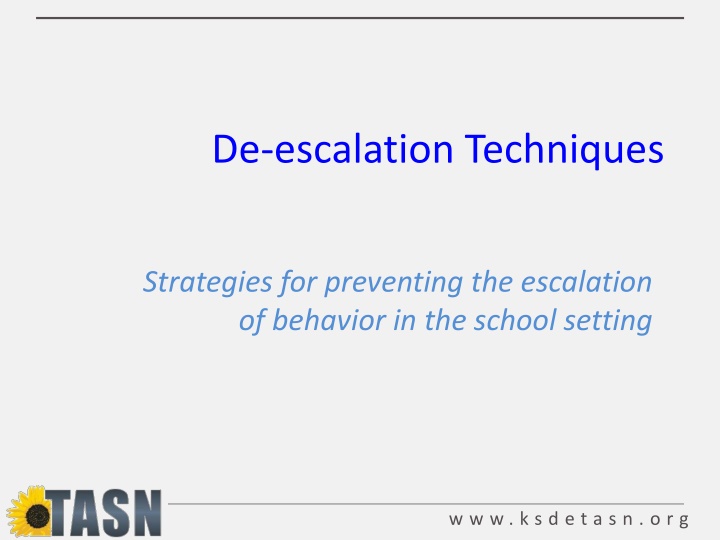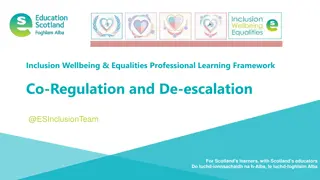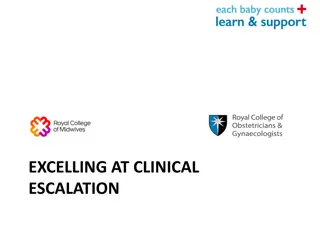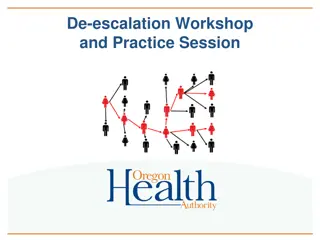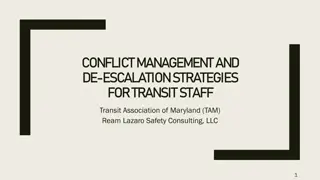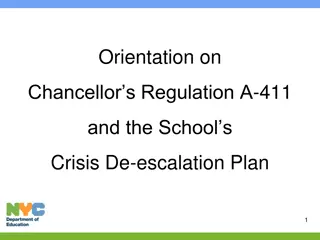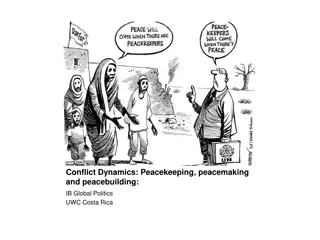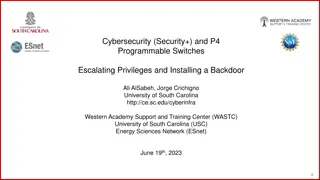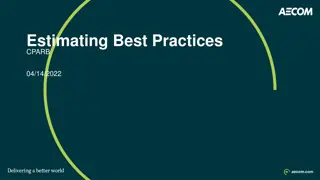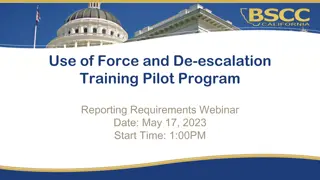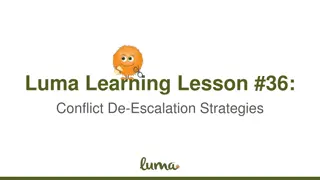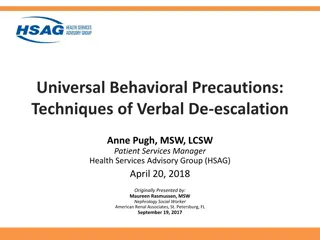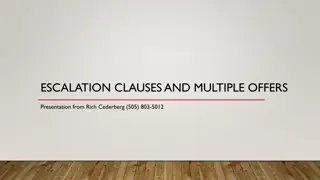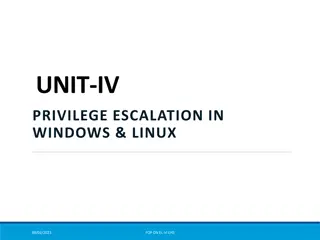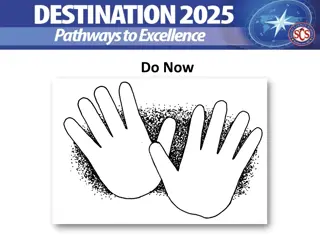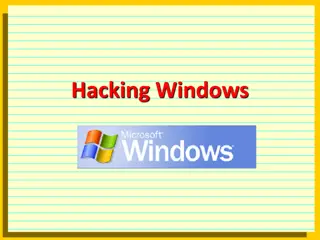Effective De-escalation Techniques for School Settings
Explore strategies and techniques for preventing behavior escalation in schools based on the work of experts like Dr. Geoff Colvin and Dr. George Sugai. Understand the importance of managing disruptive behaviors, proactive interventions, and stages of escalating behavior. Discover how to become fluent in responding to challenging behaviors and shift towards prevention rather than reaction for successful classroom management.
Download Presentation

Please find below an Image/Link to download the presentation.
The content on the website is provided AS IS for your information and personal use only. It may not be sold, licensed, or shared on other websites without obtaining consent from the author.If you encounter any issues during the download, it is possible that the publisher has removed the file from their server.
You are allowed to download the files provided on this website for personal or commercial use, subject to the condition that they are used lawfully. All files are the property of their respective owners.
The content on the website is provided AS IS for your information and personal use only. It may not be sold, licensed, or shared on other websites without obtaining consent from the author.
E N D
Presentation Transcript
De-escalation Techniques Strategies for preventing the escalation of behavior in the school setting w w w . k s d e t a s n . o r g
Acknowledgements Training Material Based on the Work of: Dr. Geoff Colvin, Behavior Associates Dr. George Sugai, University of Connecticut Dr. Kathleen Lane, University of Kansas Dr. Terry Scott, University of Louisville w w w . k s d e t a s n . o r g
OUTCOMES Understand why it is important to be able to effectively manage disruptive and noncompliant behaviors Understand problem behaviors occur within the acting-out cycle Identify proactive, preventative strategies that may decrease the occurrence of escalating behavior Identify the seven phases of escalating behavior and ways to intervene during each phase of the cycle and the importance of intervening early in an escalation
Goal: To become FLUENT so you respond in a planned way that is automatic and smooth when problem behaviors occur. What will you stop doing? What will you start doing? What do you need to know more about? What support do you need from others? Notes w w w . k s d e t a s n . o r g Schmitz, 2014
Key Message We know far more about effective prevention strategies than we do about how to address challenging behavior once it occurs. w w w . k s d e t a s n . o r g
A Shift in Thinking about Behavior Support Moving from Control and Exclusion Effective Prevention & Intervention to the key to successful classroom management is to prevent problems before they start, not knowing how to deal with problems after they have begun. Brophy & Everston w w w . k s d e t a s n . o r g
The Role of Adults Effective classroom managers are known, not by what they do when misbehavior occurs, but by what they do to set their classroom up for academic success and prevent problems from occurring. w w w . k s d e t a s n . o r g
Quote #2 Quote #1 Educators who approach discipline as a process of establishing and maintaining effective learning environments tend to be more successful than educators who place more emphasis on their roles as authority figures or disciplinarians. Good & Brophy Unfortunately, most of the practical techniques used by teachers to respond to acting- out children are only of limited effectiveness and some, such as reprimands, arguing, and escalated hostile interactions, can actually strengthen the behaviors they are intended to suppress or terminate. - Hill Walker , 1995 How do these quotes align (or not) with the present thinking of your staff? What attitudes or beliefs do staff in your building have that reflect a traditional view of behavior management?
When acting out behavior occurs, we often tend to only look at end incident. We must look earlier and focus on these critical components: 1. Prerequisite Academic Skills 2. Signs of Agitation 3. Presence of Escalating Behavior Chain 4. Presence of Successive Interactions Low achievement and problem behaviors go hand in hand ~Kauffman, 1997 p.247 w w w . k s d e t a s n . o r g
Worksheet w w w . k s d e t a s n . o r g
Student Staff
FUNDAMENTAL ASSUMPTIONS Behavior is learned (function). Behavior is lawful (function). Behavior is escalated through successive interactions (practice). Behavior can be changed through an instructional approach. w w w . k s d e t a s n . o r g
Responding Personally to Problem Behavior Teachers may take student behaviors personally and react in a way that makes the student behavior worse Teachers may abandon logical or best-practices responses (that they may use when calm) because they take behaviors personally (Diffusing Disruptive Behavior in the Classroom, p. 21) w w w . k s d e t a s n . o r g
Responding Personally to Problem Behavior Why? 1) cultural/value based 2) authority in question 3) students know how to push buttons Need to address problem student behaviors in effective ways and not escalate student behaviors (Diffusing Disruptive Behavior in the Classroom, p. 21) w w w . k s d e t a s n . o r g
Two Essential Components for Managing Severe Acting-Out Behavior 1. Understand the Model Specific behaviors for each phase Know exactly where the student is in the cycle (placement in Model). 2. Develop strategies for each phase Implement strategies based on student placement and needs w w w . k s d e t a s n . o r g
The Model: Seven Phases of The Escalation or Acting-out Cycle Peak Covin & Sugai, 1989; Colvin, 2004 De-escalation Acceleration Whether the problem behavior is managed safely or not or is defused in large measure depends on YOUR INITIAL RESPONSE Agitation Recovery Trigger -Dr. Geoff Colvin Calm Student s ability to cognitively process what is happening in the environment.
The best time to intervene on problem behavior is when the behavior is not occurring (Carr et al., 2002, p.9) Behavior Consequence Antecedent w w w . k s d e t a s n . o r g
The Model: Seven Phases of The Escalation or Acting-out Cycle Peak Colvin & Sugai, 1989; Colvin, 2004 De-escalation Acceleration Agitation Recovery Trigger Calm Student s ability to cognitively process what is happening in the environment.
Strategies for Responding to Each Phase of the Acting-Out Cycle w w w . k s d e t a s n . o r g
Phase One - Calm Student is cooperative and behavior is acceptable. Accepts corrective feedback Follows directives Sets personal goals Ignores distractions Calm Accepts praise On-task What are other characteristics of students in the calm phase? w w w . k s d e t a s n . o r g Schmitz, 2014
If you expect it you must TEACH it! Strategies 1. Calm Intervention is focused on proactive interventions. Focus on instruction and positive behavior support. Arrange for high rates of successful academic & social engagements Use positive reinforcement Teach social skills Communicate positive expectations w w w . k s d e t a s n . o r g
Phase Two - Trigger Also called antecedents Conflicts/Failure Demands Changes in routine Trigger Pressure Ineffective problem solving Facing correction procedures Non-school based triggers What are other triggers do you see? w w w . k s d e t a s n . o r g Schmitz, 2014
Strategies 2. Trigger Intervention is focused on prevention and redirection. Increase opportunities for success (e.g., pre-correction) Respond to students exhibiting expected behavior Reinforce the student s first on task response Intermittently reinforce on-task behavior Pattern of behavior? Look at formal programs/services. Address non-school based triggers. w w w . k s d e t a s n . o r g
Pre-Correction (Colvin, Sugai, & Patching, 1993) Anticipating problem behavior and intervening before hand. Pre-correction statements should be provided prior to the students involvement in particularly problematic behavior or prior to unstructured activities. This will help facilitate the development of self- regulation skills. w w w . k s d e t a s n . o r g
Phase Three - Agitation Overall behavior is unfocused and distracted often due to an inability to handle the trigger(s). Off-task Questioning/Arguing Out of seat and other movement Agitation Bothering others Social withdrawal What are other characteristics of students who are agitated? w w w . k s d e t a s n . o r g Schmitz, 2014
Strategies 3. Agitation Intervention is focused on reducing anxiety. Implement beforeonset of escalation 1. Avoid escalation responses (use empathy) 2. If not addressed student may escalate or remain distracted making instruction difficult 3. Provide reasonable options & choices 4. Involve in successful engagement (behavior momentum) w w w . k s d e t a s n . o r g
Defusing Off-Task Behavior 1. Assess the situation: determine can t do or won t do (Is it an emergency situation? If so, follow crisis procedures. If not, follow off-task defusing steps) 2. Maintain the flow of instruction. 3. Recognize on-task students, making no response to off-task students. 4. Redirect (focus on task, brief language/gestures, prompt student of procedures for asking for help). 5. Praise compliance. w w w . k s d e t a s n . o r g
Keys to Addressing Provocative Behavior (profanity, vulgarity, inappropriate actions/attire) Teach what is and is not acceptable Have a standard consequence and teach it Provide warning and correction first Speak privately to student Identify as a problem for the student Ask the student to take care of the problem Present options and ask the student to select one Acknowledge cooperation Follow through with bottom line consequence Scott, 2014 w w w . k s d e t a s n . o r g
Keys to Addressing Disruptive Behavior Recognize and respond quickly to student agitation Redirect Clearly state the expected task Communicate concern Present options Allow space do not hover Assist student to begin work Attend to other students and prepare for the worst Acknowledge compliance or institute standard consequence in neutral manner Scott, 2014 w w w . k s d e t a s n . o r g
Phase Four - Acceleration Overall behavior is staff-engaging- leading to further negative interactions. Questioning/Arguing/Threats Noncompliance and defiance Provocation of others Rule violations Acceleration What are other characteristics of accelerated behavior? w w w . k s d e t a s n . o r g Schmitz, 2014
Other Signs of Escalating Behavior Non-compliance/defiance Verbal abuse Disruption Destruction of property Whining/crying Limit testing Threats and intimidation Escape/avoidance w w w . k s d e t a s n . o r g
Keys to Addressing Non-Compliance and Defiance Teach what student is to do and be clear about what student is to do Provide reminders especially at times where non-compliance is predictable Have a standard consequence (or sequence) and teach it Acknowledge the students who are on task/complying Speak to student quietly rather than in front of entire group Provide a single specific direction Stay with the direction broken record Acknowledge student cooperation or follow through with consequence Continue to acknowledge other on-task students Scott, 2014 w w w . k s d e t a s n . o r g
Last Opportunity to Avoid Peak Behavior!!! Strategies 4. Acceleration Intervention is focused on safety. Remove all triggering factors Avoid escalating prompts Maintain calmness, respect and detachment Approach the student in a nonthreatening manner Utilize non-confrontational limit-setting procedures w w w . k s d e t a s n . o r g
Techniques that BACKFIRE Holding a grudge Raising your voice- yelling Nagging Drawing unrelated persons into the conflict Preaching Using sarcasm Making assumptions Bringing up unrelated events Making comparisons with siblings or other students Insisting you are right Insisting on having the last word Attacking the student s character What are other responses you have used or seen used that have or have the potential to backfire? w w w . k s d e t a s n . o r g
Phase Five - Peak Overall behavior is out of control creating safety concerns. Physical aggression Severe tantrums Property destruction Self-injury Running, screaming Peak Others? w w w . k s d e t a s n . o r g Schmitz, 2014
Strategies 5. Peak Intervention is focused on safety only! Focus is on crisis management Behavioral Emergency Room Clear example Safe strategies - emergency safety intervention if there is a reasonable and immediate danger of physical harm to the student or others with the present ability to effect such physical harm. (If emergency safety intervention is used, document the incident and notify parents, as required by law.) Learn from it (Functional Behavior Assessment, Behavior Intervention Plan, Mental Health Assessment, etc.) w w w . k s d e t a s n . o r g
Keys to Addressing Fighting and Aggressive Behavior Recognize conditions under which fights are likely and attempt to avoid Assign seats Space, options, preferred activities Teacher proximity stay between as long as there is no physicality Independent activities Relaxation activities If altercation becomes verbal - intervene verbally Provide specific and concrete directions Redirect get attention off of altercation Separate as much as possible without placing hands on students If altercation becomes physical - initiate crisis procedures Call office or send runner Provide clear, loud, and concrete directions to both students Clear other students away to keep safe Wait for assistance
Responses to AVOID o Agitated behavior from staff (shouting) o Cornering the student o Engaging in power struggles o Moving into the student s space o Touching or grabbing the student o Sudden or very quick responses o Making derogatory statements about the student o Arguing/becoming defensive o Body language that communicates anger or frustration o Do not communicate urgency to gain control w w w . k s d e t a s n . o r g
What can I do instead? Speak calmly Speak privately Minimize body language Keep a reasonable distance; Move slowly and deliberately toward the problem situation Speak respectfully and privately Establish eye level position Be brief Stay with agenda Avoid power struggles Give student space w w w . k s d e t a s n . o r g
Phase Six - De-escalation Overall behavior shows confusion and lack of focus. Confusion Withdrawal sleep, head down De-escalation Denial Blaming others May respond to concrete directions May apologize and try to make up Others? w w w . k s d e t a s n . o r g
Strategies 6. De-escalation Intervention is focused on monitoring for re-escalation of behavior Monitor for health/safety of all involved Avoid blaming- provide opportunity for non- judgmental discussion Allow cool-down time and space Engage in independent work- provide easy/concrete tasks w w w . k s d e t a s n . o r g
Debrief and Problem Solve After student is calm Conduct this activity following consequences - separate from consequences Use a problem solving format: 1. What did you do? (name the behavior) 2. Why did you do it? (capture student s need) 3. What else could you have done that would a. Meet your need and b. Be acceptable? w w w . k s d e t a s n . o r g
Debriefing Session Facilitates transition back to task/activity not further negative consequence. Goal is to increase appropriate behavior Focus on problem solving Pinpoint events that contributed to the incident Teach replacement behaviors Debriefing activities and forms w w w . k s d e t a s n . o r g
Phase Seven - Recovery Overall behavior shows an eagerness for busy work and a reluctance to interact. Eagerness for independent work Subdued behavior Sleep Recovery Others? w w w . k s d e t a s n . o r g
Strategies 7. Recovery Intervention focuses on returning to normal activities. Follow through with consequences-but do not disrupt flow of instruction. Positively reinforce any displays of appropriate behavior Debrief/rehearse problem solving routine Review and revise plan as needed w w w . k s d e t a s n . o r g
Four Key Strategies 1. Teach and reinforce expected behavior skills. 2. Identify how to intervene early in the escalation sequence. 3. Identify environmental factors that can be manipulated. 4. Identify replacement behaviors that can be taught. w w w . k s d e t a s n . o r g
Student Staff
Activity Describe an event in which the student s behavior escalates. Be sure to describe all seven phases of the acting-out cycle. How can you prevent acting-out behavior? How can you tell when a student s behavior is escalating? What do you do when a student is acting out? How do you deal with a student who is fully escalated? Identify strategies to increase appropriate behavior and decrease inappropriate behavior. Complete the escalation cycle worksheet for this student.
Proactive Strategies Have a school-wide positive behavior support system in place Emphasize quality instruction and engagement leading to increased academic achievement Emphasize teaching and prevention techniques w w w . k s d e t a s n . o r g
Goal: To become FLUENT so you respond in a planned way that is automatic and smooth when problem behaviors occur. What will you stop doing? What will you start doing? What will you take back to your school/classroom and do differently tomorrow? What do you need to know more about? What support do you need from others? Time to Action Plan! w w w . k s d e t a s n . o r g
